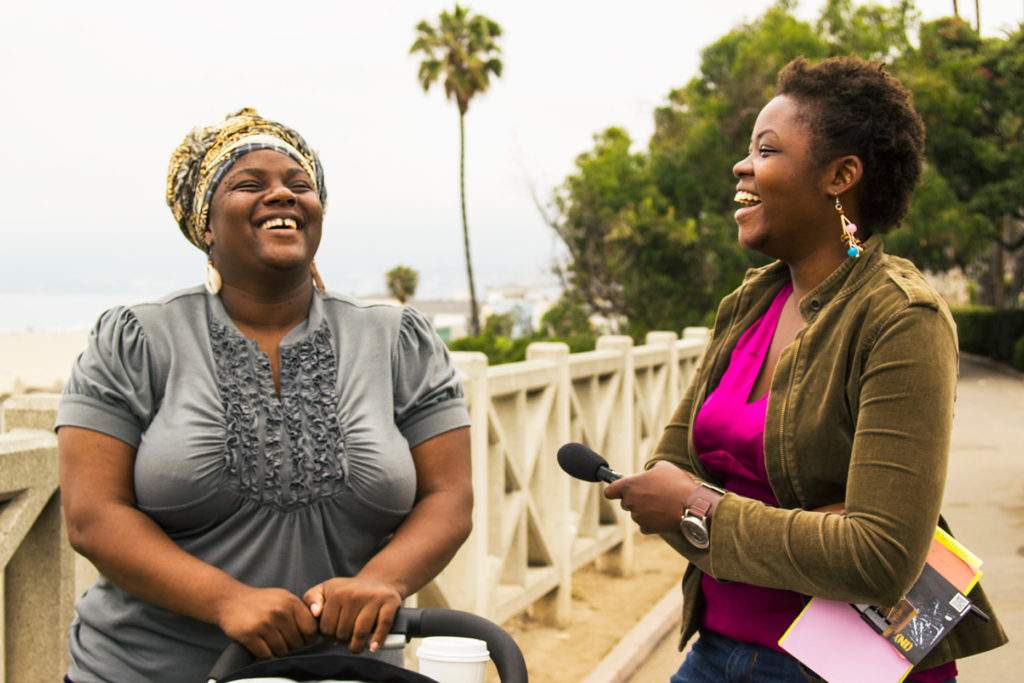Lorena Cotza
From the UK to China: journalist Beatrice Ngalula Kabutakapua and film-maker Gianpaolo Angelo Bucci travel around the world to discover those places “visible and invisible at the same time”, where migrants from sub-Saharan countries are living.
Multicultural suburbs, ghettos, ethnic enclaves: far away from the spotlight, in every city migrant communities develop their own little, secret neighbourhoods. We know they exist, sometimes we catch a glimpse of them, but we never stop to watch them closely.
They are part of our cities, but they are kept segregated and hidden behind a wall of prejudice and stereotypes. (IN)VISIBLE CITIES, the documentary by the journalist Beatrice Ngalula Kabutakapua and film-maker Gianpaolo Angelo Bucci, tries to break that wall and see what lies beyond.
“The cities we describe in our documentary are visible and invisible at the same time; everyone knows where they are, but they don’t exist for the media. They are considered dangerous and dodgy places, where nobody wants to go,” explains Beatrice, freelance journalist born in Italy but of Congolese origin.
The documentary tells the stories of the sub-Saharan African Diaspora in 13 cities and five continents. Beatrice and Gianpaolo started shooting in Cardiff in March 2013 and until now they have been in New York, Los Angeles and Istanbul. The next stops will be in Brussels, Oslo, Tokyo, Brisbane, Guangzhou, Tel Aviv, Cairo, and Buenos Aires.
The initial idea was to create a photo-reportage about sub-Saharan communities living in the main European cities, but this project developed into something more ambitious when Beatrice met Gianpaolo. Together they decided to work on a long and unconventional documentary.
They stop in each city for a long time (from one to three months) and before shooting they carry out a throughout research of the migration policies of the country, the history of its migratory fluxes and even its urban planning.
“We try to stay as long as possible in the communities, to build up a strong relationship with the people we interview,” Beatrice says. “We live, we eat and we sleep with them rather than going there and put a mic in front of them just for the time of an interview. When you get to know these people well, it’s difficult to refer to them through stereotypes.”
This human, sensitive approach gives also the footage a distinctive style. Interviews are filmed without any filter and without looking for the perfect shot, but rather trying to show people daily life in a natural, simple way. “To film invisible cities we had to use an invisible camera”, Gianpaolo jokes, referring to the choice of avoiding expensive and bulky cameras.
(IN)VISIBLE CITIES is a self-funded project. Only recently Beatrice and Gianpaolo got their first sponsorship from Fiverr, a start-up offering support with graphics and transcripts. Yet, even if the project was not economically rewarding, Beatrice says that what she gained and learned from it was priceless.
The documentary tells stories that are generally ignored by traditional media: experiences of migrant entrepreneurs, successful stories, and the tales of long-established Diaspora communities. “We have met extraordinary people,” Beatrice says. “For instance, in Istanbul we met a South-African man who had moved to Turkey to study Arabic calligraphy. Now he is an artist and he makes beautiful Koran’s copies”.
Although the documentary focuses on positive stories, this doesn’t mean sadder cases were ignored. In Istanbul, for example, they met a young girl from Senegal who was living in a basement with 13 other people, in miserable conditions. “It would have been wrong to deny that these realities also exist,” Beatrice says. “But you can speak about them and still respect their dignity”.
As it shows Diaspora communities in all their aspects, (IN)VISIBLE CITIES opens up a reflection around the meaning of integration and the sense of identity and belonging. Some interviewees are pleased with social policies adopted in the last few years. Others are more critical and wonder whether we can really speak about integration, when the majority of migrants are unemployed or forced to accept low-paid jobs.
While shooting the documentary, Beatrice and Gianpaolo have also organised some events and school activities. During one of their workshops in a school, they showed the pupils three photos: the Pope, the footballer Ronaldo and an African migrant just landed in Lampedusa. The question “Whichone is a migrant?” challenged the idea that only poor and desperate people can be “migrants”.
“During one of these meetings an 11-year-old kid asked me: why the television only shows people coming to Italy with boats?”, says Gianpaolo. “To answer this simple question, we began to explain our project and try to break stereotypes”.
“The documentary has been an opportunity to tell stories we all share— Gianpaolo adds— who hasn’t been in a new place to start a new life? Who hasn’t moved elsewhere to look for a job? And who, at least once in her or his life, hasn’t felt like a migrant?”
(IN)VISIBLE CITIES is currently being screened in Italy and will tour European cities in 2015 and then the other continents. To get in touch with Beatrice and Gianpaolo you can visit the Facebook page of (IN)VISIBLE CITIES or write to look@invisiblecities.us.
Lorena Cotza has recently graduated with a Master’s degree in International Journalism, at Cardiff University. Her research interests are immigration and human rights, with a specific focus on the phenomenon of unaccompanied immigrant children in Italy and the risks faced by these young migrants
